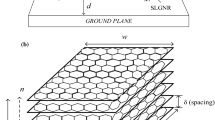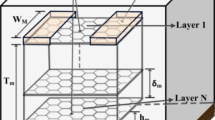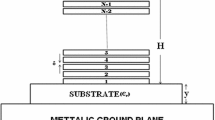Abstract
Intercalation doping is emerging as a prospective solution to enhance the performance of graphene nanoribbon interconnects. In this paper, the radio frequency (RF) analysis of stage-2 arsenic pentafluoride- and lithium-doped multilayer graphene nanoribbons (MLGNRs) has been carried out for global-level interconnects in terms of skin depth, surface impedance, critical ratio (CR), transfer gain, and 3-dB bandwidth. The skin-depth results demonstrate that doped MLGNRs exhibit minimum performance degradation primarily due to their higher conductivity, mean free path, and momentum relaxation time as compared to neutral MLGNR. An equivalent second-order accurate RLC model of an intercalation-doped MLGNR has been used to extract the transfer gain and 3-dB bandwidth results at 14-nm technology node for global-level interconnects. The results are further evaluated by implementing an advanced π-type equivalent single conductor derived from multi-conductor transmission line model. The doped MLGNR interconnects demonstrate 11-fold enhancement of 3-dB bandwidth as compared to copper (Cu). Also, the delay and energy-delay-product (EDP) computations in time domain for doped MLGNR interconnects exhibit nearly 10 times lesser delay and significant reduction in EDP than Cu counterparts. It is also observed that optimum values for 3-dB bandwidth and EDP parameters for intercalated MLGNRs could be achieved through width optimization. The RF and transient results validate intercalated MLGNRs as a potential candidate to replace Cu for next-generation global-level interconnects.










Similar content being viewed by others
References
Burke, P.J.: Luttinger liquid theory as a model of the gigahertz electrical properties of carbon nanotubes. IEEE Trans. Nanotechnol. 1(5), 129–144 (2002)
Naeemi, A., Meindl, J.D.: Conductance modeling for GNR interconnect. IEEE Electron Device Lett. 28(5), 428–431 (2007)
Naeemi, A., Meindl, J.D.: Design and performance modeling for single-walled carbon nanotubes as local, semiglobal, and global interconnects in gig scale integrated systems. IEEE Trans. Electron Devices 54(1), 26–37 (2007)
Li, H., Yin, W.Y., Banerjee, K., Mao, J.F.: Circuit modeling and performance analysis of multi-walled carbon nanotube interconnects. IEEE Trans. Electron Devices 55(6), 1328–1337 (2008)
Novoselov, K.S., Falko, V.I., Colombo, L., et al.: A roadmap for Graphene. Nature 490, 192–200 (2012)
Zhang, R., Zhao, W.S., Hu, J., Yin, W.Y.: Electrothermal characterization of multilevel Cu-graphene heterogeneous interconnects in the presence of an electrostatic discharge (ESD). IEEE Trans. Nanotechnol. 14(2), 205–209 (2015)
Singh, A.K., Auton, G., Hill, E., Song, A.M.: Graphene based ballistic rectifiers. Carbon 84, 124–129 (2015)
Xu, C., Li, H., Banerjee, K.: Modeling, analysis, and design of graphene nano-ribbon interconnects. IEEE Trans. Electron Device 56(8), 1567–1578 (2009)
Balandin, A.A., Ghosh, S., Bao, W., et al.: Superior thermal conductivity of single-layer graphene. Nano Lett. 8(3), 902–907 (2008)
Naeemi, A., Meindl, J.D.: Compact physics-based circuit models for graphene nanoribbon interconnects. IEEE Trans. Electron Devices 56(9), 1822–1833 (2009)
Reddy, K.N., Majumder, M.K., Kaushik, B.K.: Delay uncertainty in MLGNR interconnects under process induced variations of width, doping, dielectric thickness and mean free path. J. Comput. Electron. 13(3), 639–646 (2014)
Rai, M.K., Chatterjee, A.K., Sarkar, S., et al.: Performance analysis of multilayer graphene nanoribbon (MLGNR) interconnects. J. Comput. Electron. 15(2), 358–366 (2016)
Kumar, V., Rakheja, S., Naeemi, A.: Performance and energy-per-bit modeling of multilayer graphene nanoribbon conductors. IEEE Trans. Electron Devices 59(10), 2753–2761 (2012)
Kumar, V.R., Majumder, M.K., Kukkam, N.R., Kaushik, B.K.: Time and frequency domain analysis of MLGNR interconnects. IEEE Trans. Nanotechnol. 14(3), 484–492 (2015)
Zhao, S., Yin, W.Y.: Comparative study on multilayer graphene nanoribbon (MLGNR) interconnects. IEEE Trans. Electromagnetic Compatibility 56(3), 638–645 (2014)
Kaur, M., Gupta, N., Singh, A.K.: Impact of geometrical parameters on performance of MWCNT based chip interconnects. In: Proceedings of Progress In: Electromagnetics Research Symposium (PIERS), 988–993 2017
Kaur, M., Gupta, N., Singh, A.K.: Performance Analysis of Multilayer Graphene Nanoribbon Based Interconnects. In: Proceedings of IEEE MTT-S International Microwave and RF Conference (IMaRC), 176–179 2017
Kaur, M., Gupta, N., Singh, A.K.: Crosstalk analysis of coupled MLGNR interconnects with different types of repeater insertion. J. Microprocessors and Microsystems. 67, 18–27 (2019)
Singh, K., Raj, B.: Temperature-dependent modeling and performance evaluation of multi-walled CNT and single-walled CNT as global interconnects. J. Electron. Mater. 44(12), 4825–4835 (2015)
Rai, M.K., Garg, H., Kaushik, B.K.: Temperature-dependent modeling and crosstalk analysis in mixed carbon nanotube bundle interconnects. J. Electron. Mater. 46(8), 5324–5337 (2017)
Sharma, H., Singh, K.: Thermally aware modeling and performance analysis of MLGNR as on-chip VLSI interconnect material. J. Electron. Mater. 48(8), 4902–4912 (2019)
Singh, K., Thakur, A.: Comparative analysis of mixed CNTs and MWCNTs as VLSI interconnects for deep sub-micron technology nodes. J. Electron. Mater. 48(4), 2543–2554 (2019)
Kaur, T., Rai, M.K., Khanna, R.: Effect of temperature on the performance of MLGNR interconnects. J. Comput. Electron. 18(2), 722–736 (2019)
Das, S., Das, D., Rahaman, H.: Electro-thermal RF modeling and performance analysis of graphene nanoribbon interconnects. J. Comput. Electron. 17(4), 1695–1708 (2018)
Kumar, V.R., Majumder, M.K., Alam, A., et al.: Stability and delay analysis of multi-layered GNR and multi-walled CNT interconnects. J. Comput. Electron. 14(2), 611–618 (2015)
Bhattacharya, S., Das, D., Rahaman, H.: Reduced thickness interconnect model using GNR to avoid crosstalk effects. J. Comput. Electron. 15(2), 367–380 (2016)
Bhattacharya, S., Das, S., Mukhopadhyay, A., et al.: Analysis of a temperature-dependent delay optimization model for GNR interconnects using a wire sizing method. J. Comput. Electron. 17(4), 1536–1548 (2018)
Bagheri, A., Ranjbar, M., Haji-Nasiri, S., et al.: Modelling and analysis of crosstalk induced noise effects in bundle SWCNT interconnects and its impact on signal stability. J. Comput. Electron. 16(3), 845–855 (2017)
Li, H., Banerjee, K.: High-frequency analysis of carbon nanotube interconnects and implications for on-chip inductor design. IEEE Trans. Electron Devices. 56(10), 2202–2214 (2009)
Sarkar, D., Xu, C., Li, H., Banerjee, K.: High-frequency behavior of graphene-based interconnects—Part I: impedance modeling. IEEE Trans. Electron. Devices. 58(3), 843–852 (2011)
Sarkar, D., Xu, C., Li, H., Banerjee, K.: High-frequency behavior of graphene-based interconnects—Part I: impedance analysis and implications for inductor design. IEEE Trans. Electron Devices 58(3), 853–859 (2011)
Qian, L., Xia, Y., Shi, G.: Study of crosstalk effect on the propagation characteristics of coupled MLGNR interconnects. IEEE Trans. Nanotechnol. 15(5), 810–819 (2016)
Kumar, P., Singh, A., Garg, A., Sharma, R.: Compact models for transient analysis of single-layer graphene nanoribbon interconnects. In: Proceedings of 15th UKSim Computer Modelling and Simulation, 809–814 2013
Bhattacharya, S., Das, D., Rahaman, H.: Stability analysis in top contact and side-contact graphene nanoribbon interconnects. IETE J. Res. 63(4), 588–596 (2017)
Nishad, A.K., Sharma, R.: Analytical time-domain models for performance optimization of multilayer GNR interconnects. IEEE J. Sel. Top. Quantum Electron. 20(1), 17–24 (2014)
Dresselhaus, M.S., Dresselhaus, : Intercalation compounds of graphite. Adv. Phys. 51(1), 1–186 (2002)
Nishad, A.K., Sharma, R.: Lithium-intercalated graphene interconnects: prospects for on-chip applications. IEEE J. Electron Devices Soc. 4(6), 485–489 (2016)
Kumbhare, V.R., Paltani, P.P., Venkataiah, C., Majumder, M.K.: Analytical study of bundled MWCNT and edged MLGNR interconnects: impact on propagation delay and area. IEEE Trans. Nanotechnol. 18, 606–610 (2019)
Singh, A.K., Auton, G., Hill, E., Song, A.: Estimation of intrinsic and extrinsic capacitances of graphene self-switching diode using conformal mapping technique. 2D Mater. 5(3), 035023 (2018)
Garg, S., Kaushal, B., Kumar, S., Kasjoo, S.R., Mahapatra, S., Singh, A.K.: Extraction of trench capacitance and reverse recovery time of InGaAs self-switching diode. IEEE Trans. on Nanotech. 18, 925–931 (2019)
Garg, A., Jain, N., Singh, A.K.: Modeling and simulation of a graphene-based three-terminal junction rectifier. J. Comput. Electron. 17(2), 562 (2018)
Singh, A.K., Kasjoo, S.R., Song, A.M.: Low-frequency noise of a ballistic rectifier. IEEE Trans. on Nanotech. 13(3), 527–531 (2014)
Garg, A., Jain, N., Kumar, S., Kasjoo, S.R., Singh, A.K.: Analysis of nonlinear characteristics of a graphene based four-terminal ballistic rectifier using a drift-diffusion model. Nanoscale Adv. 10, 1–9 (2019)
Rakheja, S., Kumar, V., Naeemi, A.: Evaluation of the potential performance of graphene nanoribbons as on chip interconnects. Proc IEEE 101(7), 1740–1765 (2013)
Sondheimer, E.H.: The mean free path of electrons in metals. Adv. Phys. 50(6), 499–537 (2001)
Reuter, G.E.H., Sondheimer, E.H.: The theory of the anomalous skin effect in metals. Proc Royal Soc. A: Math. Phys. Sci. 195, 336–364 (1948)
Benedict, L.X., Crespi, V.H., Louie, S.G., Cohen, M.L.: Static conductivity and superconductivity of carbon nanotubes: relations between tubes and sheets. Phys. Rev. B Condens. Matter. 52(20), 14935–14940 (1995)
Bao, W., Wan, J., Han, X., et al.: Approaching the limits of transparency and conductivity in graphitic materials through lithium intercalation. Nat. Commun. 5(4224), 1–9 (2014)
Kerr, A.R.: Surface impedance of superconductors and normal conductors in EM simulators. NRAO Electron Division, MMA Memo 245, 1–16 (1999)
International Technology Roadmap for Semiconductors (ITRS-2007) Reports, [Online]. Available: https://www.itrs.net/reports.html
Amore, M.D., Sarto, M.S., Tamburrano, A.: Fast transient analysis of next generation interconnects based on carbon nanotubes. IEEE Trans. Electromagn. Compat. 52(2), 496–503 (2010)
Dworsky, L.N.: Modern Transmission Line Theory and Applications. John Wiley & Sons, New York (1979)
Author information
Authors and Affiliations
Corresponding author
Ethics declarations
Conflict of interest
The authors declare that they have no conflict of interest.
Additional information
Publisher's Note
Springer Nature remains neutral with regard to jurisdictional claims in published maps and institutional affiliations.
Rights and permissions
About this article
Cite this article
Kaur, M., Gupta, N., Kumar, S. et al. RF analysis of intercalated graphene nanoribbon-based global-level interconnects. J Comput Electron 19, 1002–1013 (2020). https://doi.org/10.1007/s10825-020-01530-5
Published:
Issue Date:
DOI: https://doi.org/10.1007/s10825-020-01530-5




